Strategic Human Resource Management Report for Hilton Hotel Analysis
VerifiedAdded on 2020/01/28
|13
|3538
|68
Report
AI Summary
This report provides a comprehensive analysis of Strategic Human Resource Management (SHRM) within the context of Hilton Hotel. It begins by defining the core concepts of SHRM, emphasizing its alignment with organizational goals, and highlights the significance of HRM in various contexts. The report explores the concept of employee engagement, examining its key elements such as commitment, motivation, and loyalty. It then delves into the changing perspectives of HRM, tracing its evolution from early personal management practices to modern strategic approaches. The core of the report discusses the SHRM model, particularly Ulrich's model, and its application to Hilton Hotel, focusing on strategic partnerships, administrative expertise, change management, and employee advocacy. Furthermore, the report examines the crucial role of training and development, including on-the-job and off-the-job methods, in enhancing employee skills and performance. Finally, it addresses leadership development, emphasizing its importance in motivating and engaging employees within the Hilton Hotel group.
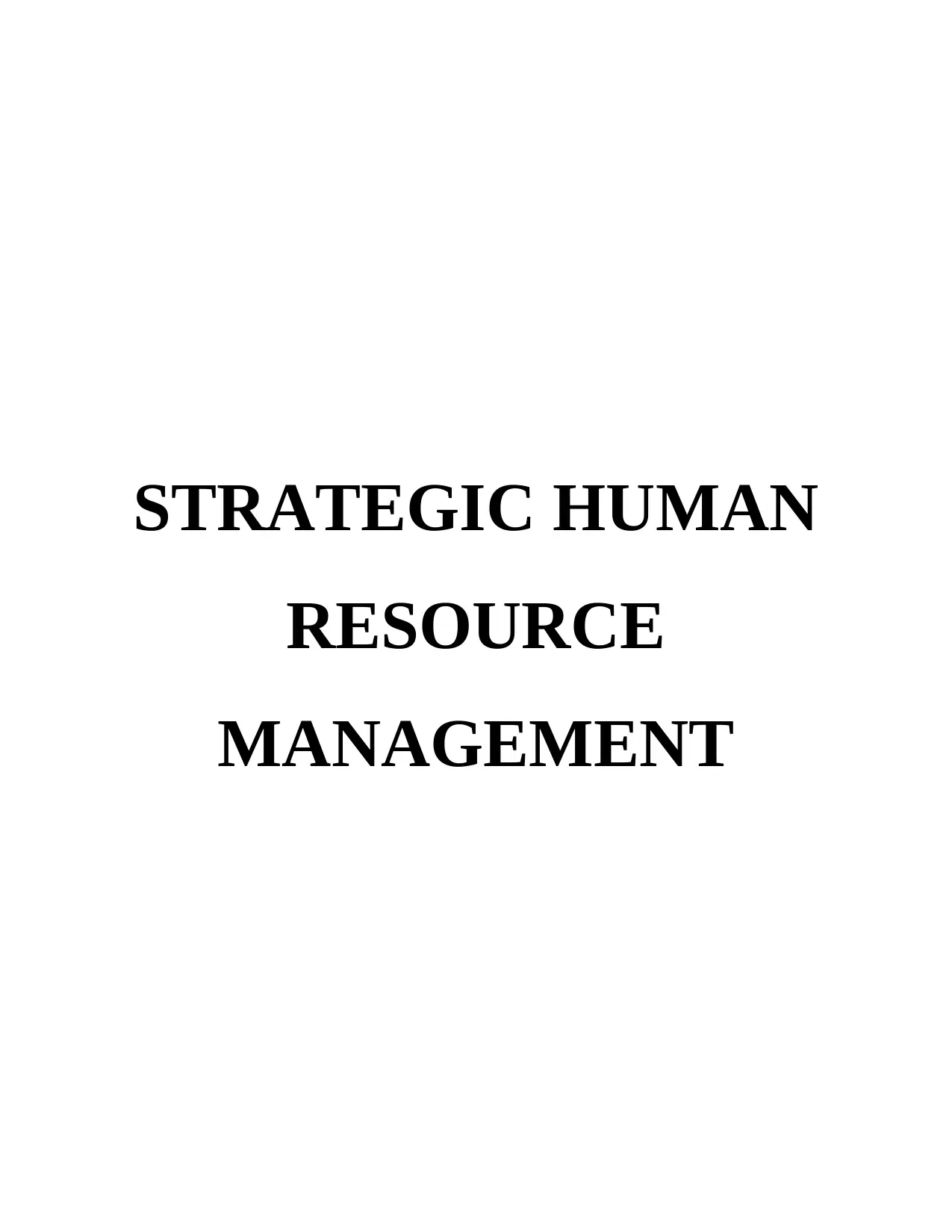
STRATEGIC HUMAN
RESOURCE
MANAGEMENT
RESOURCE
MANAGEMENT
Paraphrase This Document
Need a fresh take? Get an instant paraphrase of this document with our AI Paraphraser

Table of Contents
INTRODUCTION...........................................................................................................................1
Significance of HRM..................................................................................................................1
Employment engagement concept..............................................................................................2
Changing perspectives of HRM..................................................................................................3
Strategic Human resource management model...........................................................................3
Training and development...........................................................................................................6
Leadership development.............................................................................................................7
CONCLUSION................................................................................................................................9
REFERENCES..............................................................................................................................10
INTRODUCTION...........................................................................................................................1
Significance of HRM..................................................................................................................1
Employment engagement concept..............................................................................................2
Changing perspectives of HRM..................................................................................................3
Strategic Human resource management model...........................................................................3
Training and development...........................................................................................................6
Leadership development.............................................................................................................7
CONCLUSION................................................................................................................................9
REFERENCES..............................................................................................................................10

INTRODUCTION
The core concept of Strategic HRM consists of activities that guide and align human
resource management philosophy with strategic and long term goals of the organization. It is
strategies look at human resource functions. The report analyzes strategies which balance the
opportunities and threats of Hilton Hotel. Further, it aims to leverage HR practices to build
critical capabilities (Cummings and Worley, 2014). An effective organizational structure, design,
culture, employee value proposition and appropriate communication strategy are the key factors
of strategic HRM. The concept lays emphasis on business code of conduct, ethics and managing
societal impact of business decisions.
Significance of HRM
Human resource management deals with multiple human resource policies to achieve
organizational objectives. This branch is integration of HRM and information technology to
automate and facilitate resourceful assets. The employees are selected and motivated to
accomplish the enterprise goals (Gallicano, 2009). An effective and secured system helps in
retaining gainful workforce in Hilton hotel. The teams and individuals are motivated and offered
opportunities to get promotion. It is a well known fact that skilled and qualified human resources
are foundation stone for the company to acquire good output. In modern times, HRM plays a
significant role in recruiting, selecting, training, motivating and retaining employees of the hotel
company. Being a crucial part of the management, it builds sense of belonging and team-spirit
among unit members. In context of employees, it evokes the feeling of self-actualization in each
and every individual by realizing them their potential. Job satisfaction is built which increases
the level of contentment in the individual that ultimately affects their performance (Dezdar and
Sulaiman, 2009). The HR manger ensures that threat of unemployment, inequalities and
instability does not hinder the functioning of enterprise. This is done by maintaining good
employee-employer relations or by building proper bonding between personal goals and
organizational needs.
Human resources are valuable assets for the corporate bodies to ensure smooth
functioning of the business. Effective human resource management is required to face new
challenges regarding the changing trends, technology and knowledge (Chen and Huang, 2009).
Its significance in Hilton hotel can be highlighted in three contexts:
Organizational significance
1
The core concept of Strategic HRM consists of activities that guide and align human
resource management philosophy with strategic and long term goals of the organization. It is
strategies look at human resource functions. The report analyzes strategies which balance the
opportunities and threats of Hilton Hotel. Further, it aims to leverage HR practices to build
critical capabilities (Cummings and Worley, 2014). An effective organizational structure, design,
culture, employee value proposition and appropriate communication strategy are the key factors
of strategic HRM. The concept lays emphasis on business code of conduct, ethics and managing
societal impact of business decisions.
Significance of HRM
Human resource management deals with multiple human resource policies to achieve
organizational objectives. This branch is integration of HRM and information technology to
automate and facilitate resourceful assets. The employees are selected and motivated to
accomplish the enterprise goals (Gallicano, 2009). An effective and secured system helps in
retaining gainful workforce in Hilton hotel. The teams and individuals are motivated and offered
opportunities to get promotion. It is a well known fact that skilled and qualified human resources
are foundation stone for the company to acquire good output. In modern times, HRM plays a
significant role in recruiting, selecting, training, motivating and retaining employees of the hotel
company. Being a crucial part of the management, it builds sense of belonging and team-spirit
among unit members. In context of employees, it evokes the feeling of self-actualization in each
and every individual by realizing them their potential. Job satisfaction is built which increases
the level of contentment in the individual that ultimately affects their performance (Dezdar and
Sulaiman, 2009). The HR manger ensures that threat of unemployment, inequalities and
instability does not hinder the functioning of enterprise. This is done by maintaining good
employee-employer relations or by building proper bonding between personal goals and
organizational needs.
Human resources are valuable assets for the corporate bodies to ensure smooth
functioning of the business. Effective human resource management is required to face new
challenges regarding the changing trends, technology and knowledge (Chen and Huang, 2009).
Its significance in Hilton hotel can be highlighted in three contexts:
Organizational significance
1
⊘ This is a preview!⊘
Do you want full access?
Subscribe today to unlock all pages.

Trusted by 1+ million students worldwide
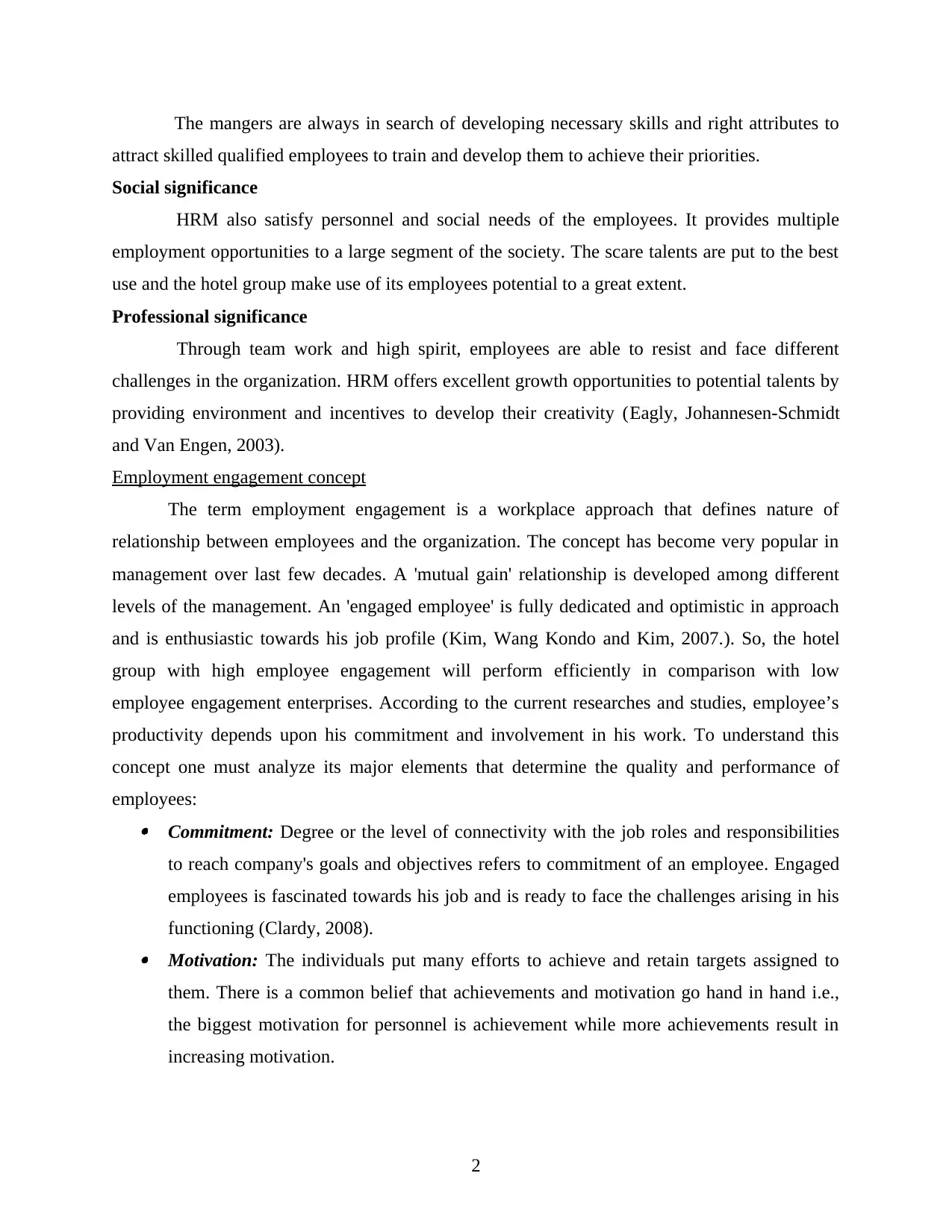
The mangers are always in search of developing necessary skills and right attributes to
attract skilled qualified employees to train and develop them to achieve their priorities.
Social significance
HRM also satisfy personnel and social needs of the employees. It provides multiple
employment opportunities to a large segment of the society. The scare talents are put to the best
use and the hotel group make use of its employees potential to a great extent.
Professional significance
Through team work and high spirit, employees are able to resist and face different
challenges in the organization. HRM offers excellent growth opportunities to potential talents by
providing environment and incentives to develop their creativity (Eagly, Johannesen-Schmidt
and Van Engen, 2003).
Employment engagement concept
The term employment engagement is a workplace approach that defines nature of
relationship between employees and the organization. The concept has become very popular in
management over last few decades. A 'mutual gain' relationship is developed among different
levels of the management. An 'engaged employee' is fully dedicated and optimistic in approach
and is enthusiastic towards his job profile (Kim, Wang Kondo and Kim, 2007.). So, the hotel
group with high employee engagement will perform efficiently in comparison with low
employee engagement enterprises. According to the current researches and studies, employee’s
productivity depends upon his commitment and involvement in his work. To understand this
concept one must analyze its major elements that determine the quality and performance of
employees: Commitment: Degree or the level of connectivity with the job roles and responsibilities
to reach company's goals and objectives refers to commitment of an employee. Engaged
employees is fascinated towards his job and is ready to face the challenges arising in his
functioning (Clardy, 2008). Motivation: The individuals put many efforts to achieve and retain targets assigned to
them. There is a common belief that achievements and motivation go hand in hand i.e.,
the biggest motivation for personnel is achievement while more achievements result in
increasing motivation.
2
attract skilled qualified employees to train and develop them to achieve their priorities.
Social significance
HRM also satisfy personnel and social needs of the employees. It provides multiple
employment opportunities to a large segment of the society. The scare talents are put to the best
use and the hotel group make use of its employees potential to a great extent.
Professional significance
Through team work and high spirit, employees are able to resist and face different
challenges in the organization. HRM offers excellent growth opportunities to potential talents by
providing environment and incentives to develop their creativity (Eagly, Johannesen-Schmidt
and Van Engen, 2003).
Employment engagement concept
The term employment engagement is a workplace approach that defines nature of
relationship between employees and the organization. The concept has become very popular in
management over last few decades. A 'mutual gain' relationship is developed among different
levels of the management. An 'engaged employee' is fully dedicated and optimistic in approach
and is enthusiastic towards his job profile (Kim, Wang Kondo and Kim, 2007.). So, the hotel
group with high employee engagement will perform efficiently in comparison with low
employee engagement enterprises. According to the current researches and studies, employee’s
productivity depends upon his commitment and involvement in his work. To understand this
concept one must analyze its major elements that determine the quality and performance of
employees: Commitment: Degree or the level of connectivity with the job roles and responsibilities
to reach company's goals and objectives refers to commitment of an employee. Engaged
employees is fascinated towards his job and is ready to face the challenges arising in his
functioning (Clardy, 2008). Motivation: The individuals put many efforts to achieve and retain targets assigned to
them. There is a common belief that achievements and motivation go hand in hand i.e.,
the biggest motivation for personnel is achievement while more achievements result in
increasing motivation.
2
Paraphrase This Document
Need a fresh take? Get an instant paraphrase of this document with our AI Paraphraser
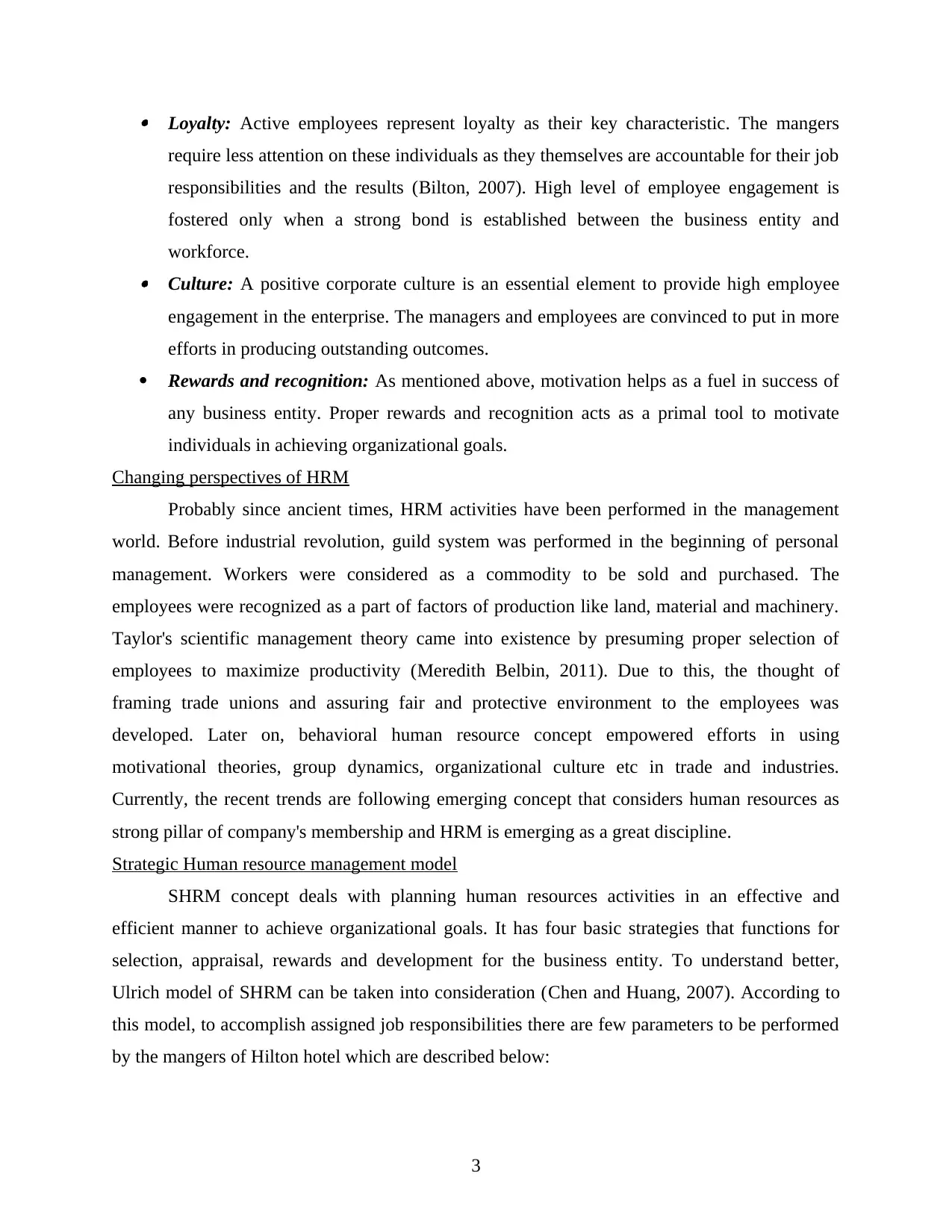
Loyalty: Active employees represent loyalty as their key characteristic. The mangers
require less attention on these individuals as they themselves are accountable for their job
responsibilities and the results (Bilton, 2007). High level of employee engagement is
fostered only when a strong bond is established between the business entity and
workforce. Culture: A positive corporate culture is an essential element to provide high employee
engagement in the enterprise. The managers and employees are convinced to put in more
efforts in producing outstanding outcomes.
Rewards and recognition: As mentioned above, motivation helps as a fuel in success of
any business entity. Proper rewards and recognition acts as a primal tool to motivate
individuals in achieving organizational goals.
Changing perspectives of HRM
Probably since ancient times, HRM activities have been performed in the management
world. Before industrial revolution, guild system was performed in the beginning of personal
management. Workers were considered as a commodity to be sold and purchased. The
employees were recognized as a part of factors of production like land, material and machinery.
Taylor's scientific management theory came into existence by presuming proper selection of
employees to maximize productivity (Meredith Belbin, 2011). Due to this, the thought of
framing trade unions and assuring fair and protective environment to the employees was
developed. Later on, behavioral human resource concept empowered efforts in using
motivational theories, group dynamics, organizational culture etc in trade and industries.
Currently, the recent trends are following emerging concept that considers human resources as
strong pillar of company's membership and HRM is emerging as a great discipline.
Strategic Human resource management model
SHRM concept deals with planning human resources activities in an effective and
efficient manner to achieve organizational goals. It has four basic strategies that functions for
selection, appraisal, rewards and development for the business entity. To understand better,
Ulrich model of SHRM can be taken into consideration (Chen and Huang, 2007). According to
this model, to accomplish assigned job responsibilities there are few parameters to be performed
by the mangers of Hilton hotel which are described below:
3
require less attention on these individuals as they themselves are accountable for their job
responsibilities and the results (Bilton, 2007). High level of employee engagement is
fostered only when a strong bond is established between the business entity and
workforce. Culture: A positive corporate culture is an essential element to provide high employee
engagement in the enterprise. The managers and employees are convinced to put in more
efforts in producing outstanding outcomes.
Rewards and recognition: As mentioned above, motivation helps as a fuel in success of
any business entity. Proper rewards and recognition acts as a primal tool to motivate
individuals in achieving organizational goals.
Changing perspectives of HRM
Probably since ancient times, HRM activities have been performed in the management
world. Before industrial revolution, guild system was performed in the beginning of personal
management. Workers were considered as a commodity to be sold and purchased. The
employees were recognized as a part of factors of production like land, material and machinery.
Taylor's scientific management theory came into existence by presuming proper selection of
employees to maximize productivity (Meredith Belbin, 2011). Due to this, the thought of
framing trade unions and assuring fair and protective environment to the employees was
developed. Later on, behavioral human resource concept empowered efforts in using
motivational theories, group dynamics, organizational culture etc in trade and industries.
Currently, the recent trends are following emerging concept that considers human resources as
strong pillar of company's membership and HRM is emerging as a great discipline.
Strategic Human resource management model
SHRM concept deals with planning human resources activities in an effective and
efficient manner to achieve organizational goals. It has four basic strategies that functions for
selection, appraisal, rewards and development for the business entity. To understand better,
Ulrich model of SHRM can be taken into consideration (Chen and Huang, 2007). According to
this model, to accomplish assigned job responsibilities there are few parameters to be performed
by the mangers of Hilton hotel which are described below:
3
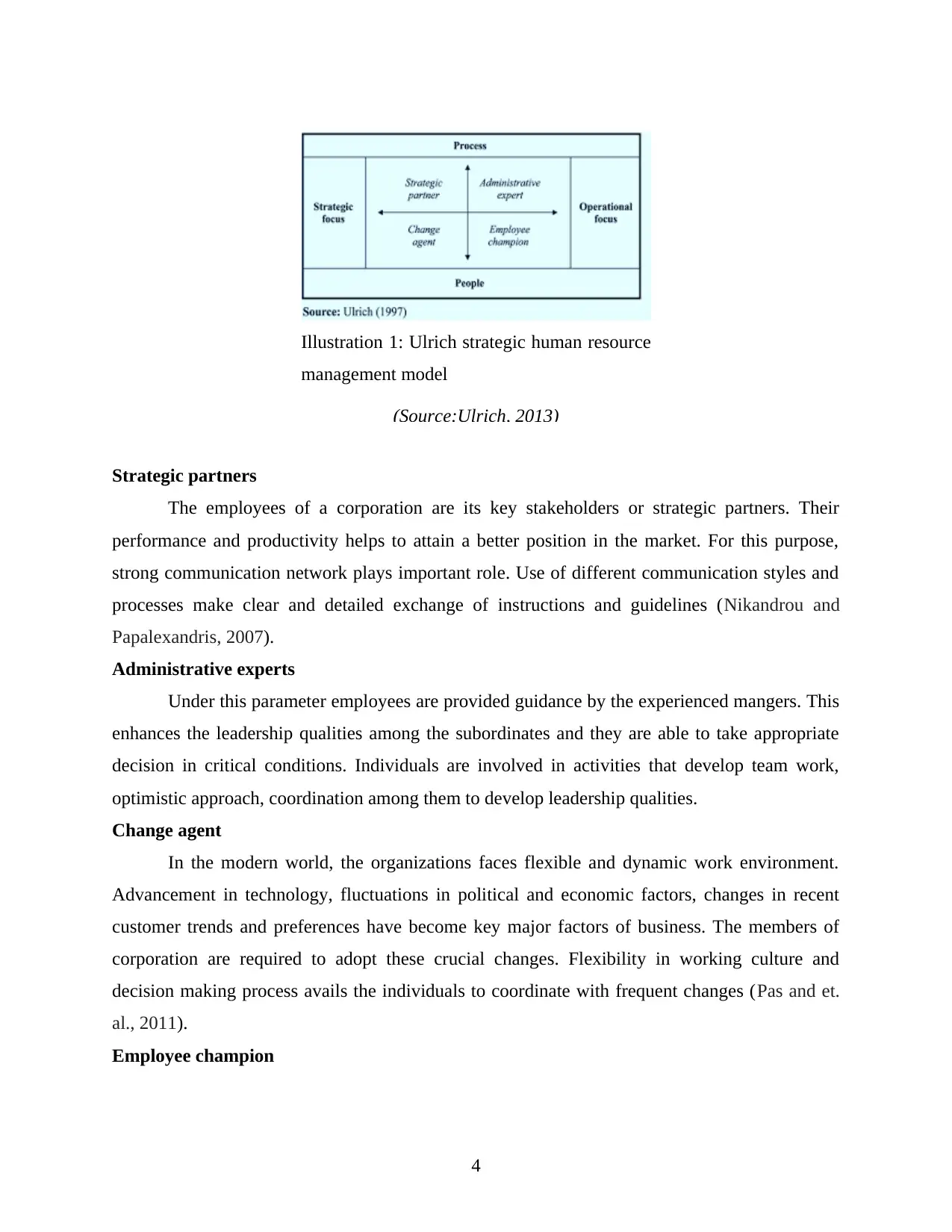
Strategic partners
The employees of a corporation are its key stakeholders or strategic partners. Their
performance and productivity helps to attain a better position in the market. For this purpose,
strong communication network plays important role. Use of different communication styles and
processes make clear and detailed exchange of instructions and guidelines (Nikandrou and
Papalexandris, 2007).
Administrative experts
Under this parameter employees are provided guidance by the experienced mangers. This
enhances the leadership qualities among the subordinates and they are able to take appropriate
decision in critical conditions. Individuals are involved in activities that develop team work,
optimistic approach, coordination among them to develop leadership qualities.
Change agent
In the modern world, the organizations faces flexible and dynamic work environment.
Advancement in technology, fluctuations in political and economic factors, changes in recent
customer trends and preferences have become key major factors of business. The members of
corporation are required to adopt these crucial changes. Flexibility in working culture and
decision making process avails the individuals to coordinate with frequent changes (Pas and et.
al., 2011).
Employee champion
4
Illustration 1: Ulrich strategic human resource
management model
(Source:Ulrich, 2013)
The employees of a corporation are its key stakeholders or strategic partners. Their
performance and productivity helps to attain a better position in the market. For this purpose,
strong communication network plays important role. Use of different communication styles and
processes make clear and detailed exchange of instructions and guidelines (Nikandrou and
Papalexandris, 2007).
Administrative experts
Under this parameter employees are provided guidance by the experienced mangers. This
enhances the leadership qualities among the subordinates and they are able to take appropriate
decision in critical conditions. Individuals are involved in activities that develop team work,
optimistic approach, coordination among them to develop leadership qualities.
Change agent
In the modern world, the organizations faces flexible and dynamic work environment.
Advancement in technology, fluctuations in political and economic factors, changes in recent
customer trends and preferences have become key major factors of business. The members of
corporation are required to adopt these crucial changes. Flexibility in working culture and
decision making process avails the individuals to coordinate with frequent changes (Pas and et.
al., 2011).
Employee champion
4
Illustration 1: Ulrich strategic human resource
management model
(Source:Ulrich, 2013)
⊘ This is a preview!⊘
Do you want full access?
Subscribe today to unlock all pages.

Trusted by 1+ million students worldwide

HR mangers needs to develop champions from their employees to enhance their growth
and development. Time-to-time training and development of the subordinates increases
knowledge and skills of the subordinates as it increases their productivity. Seminars, training
sessions, demonstration classes, site visiting etc can be used as training techniques. On the other
hand, reward management theory motivates them to a great extent. Monetary and non-monetary
benefits availed by the company increases their performance and productivity.
5
and development. Time-to-time training and development of the subordinates increases
knowledge and skills of the subordinates as it increases their productivity. Seminars, training
sessions, demonstration classes, site visiting etc can be used as training techniques. On the other
hand, reward management theory motivates them to a great extent. Monetary and non-monetary
benefits availed by the company increases their performance and productivity.
5
Paraphrase This Document
Need a fresh take? Get an instant paraphrase of this document with our AI Paraphraser
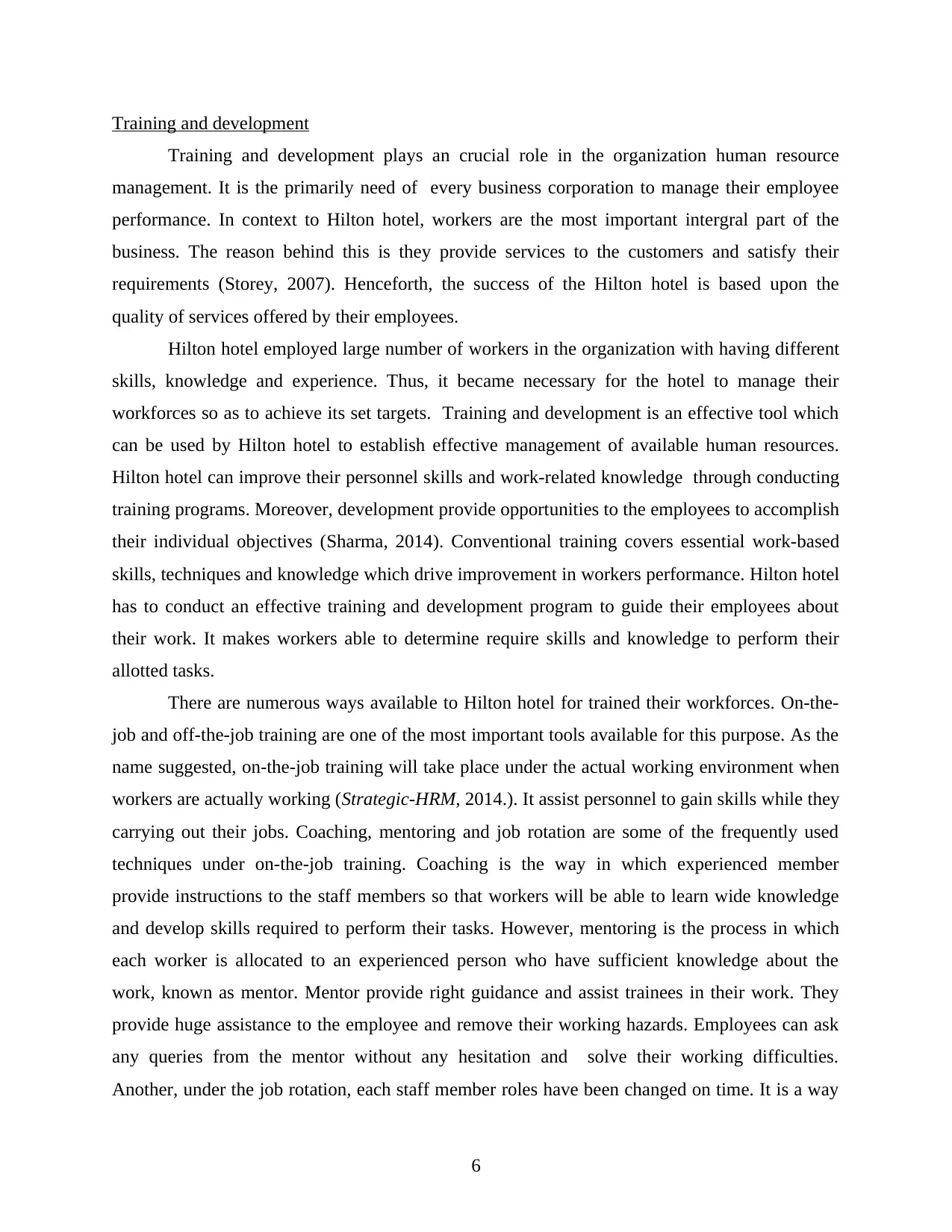
Training and development
Training and development plays an crucial role in the organization human resource
management. It is the primarily need of every business corporation to manage their employee
performance. In context to Hilton hotel, workers are the most important intergral part of the
business. The reason behind this is they provide services to the customers and satisfy their
requirements (Storey, 2007). Henceforth, the success of the Hilton hotel is based upon the
quality of services offered by their employees.
Hilton hotel employed large number of workers in the organization with having different
skills, knowledge and experience. Thus, it became necessary for the hotel to manage their
workforces so as to achieve its set targets. Training and development is an effective tool which
can be used by Hilton hotel to establish effective management of available human resources.
Hilton hotel can improve their personnel skills and work-related knowledge through conducting
training programs. Moreover, development provide opportunities to the employees to accomplish
their individual objectives (Sharma, 2014). Conventional training covers essential work-based
skills, techniques and knowledge which drive improvement in workers performance. Hilton hotel
has to conduct an effective training and development program to guide their employees about
their work. It makes workers able to determine require skills and knowledge to perform their
allotted tasks.
There are numerous ways available to Hilton hotel for trained their workforces. On-the-
job and off-the-job training are one of the most important tools available for this purpose. As the
name suggested, on-the-job training will take place under the actual working environment when
workers are actually working (Strategic-HRM, 2014.). It assist personnel to gain skills while they
carrying out their jobs. Coaching, mentoring and job rotation are some of the frequently used
techniques under on-the-job training. Coaching is the way in which experienced member
provide instructions to the staff members so that workers will be able to learn wide knowledge
and develop skills required to perform their tasks. However, mentoring is the process in which
each worker is allocated to an experienced person who have sufficient knowledge about the
work, known as mentor. Mentor provide right guidance and assist trainees in their work. They
provide huge assistance to the employee and remove their working hazards. Employees can ask
any queries from the mentor without any hesitation and solve their working difficulties.
Another, under the job rotation, each staff member roles have been changed on time. It is a way
6
Training and development plays an crucial role in the organization human resource
management. It is the primarily need of every business corporation to manage their employee
performance. In context to Hilton hotel, workers are the most important intergral part of the
business. The reason behind this is they provide services to the customers and satisfy their
requirements (Storey, 2007). Henceforth, the success of the Hilton hotel is based upon the
quality of services offered by their employees.
Hilton hotel employed large number of workers in the organization with having different
skills, knowledge and experience. Thus, it became necessary for the hotel to manage their
workforces so as to achieve its set targets. Training and development is an effective tool which
can be used by Hilton hotel to establish effective management of available human resources.
Hilton hotel can improve their personnel skills and work-related knowledge through conducting
training programs. Moreover, development provide opportunities to the employees to accomplish
their individual objectives (Sharma, 2014). Conventional training covers essential work-based
skills, techniques and knowledge which drive improvement in workers performance. Hilton hotel
has to conduct an effective training and development program to guide their employees about
their work. It makes workers able to determine require skills and knowledge to perform their
allotted tasks.
There are numerous ways available to Hilton hotel for trained their workforces. On-the-
job and off-the-job training are one of the most important tools available for this purpose. As the
name suggested, on-the-job training will take place under the actual working environment when
workers are actually working (Strategic-HRM, 2014.). It assist personnel to gain skills while they
carrying out their jobs. Coaching, mentoring and job rotation are some of the frequently used
techniques under on-the-job training. Coaching is the way in which experienced member
provide instructions to the staff members so that workers will be able to learn wide knowledge
and develop skills required to perform their tasks. However, mentoring is the process in which
each worker is allocated to an experienced person who have sufficient knowledge about the
work, known as mentor. Mentor provide right guidance and assist trainees in their work. They
provide huge assistance to the employee and remove their working hazards. Employees can ask
any queries from the mentor without any hesitation and solve their working difficulties.
Another, under the job rotation, each staff member roles have been changed on time. It is a way
6
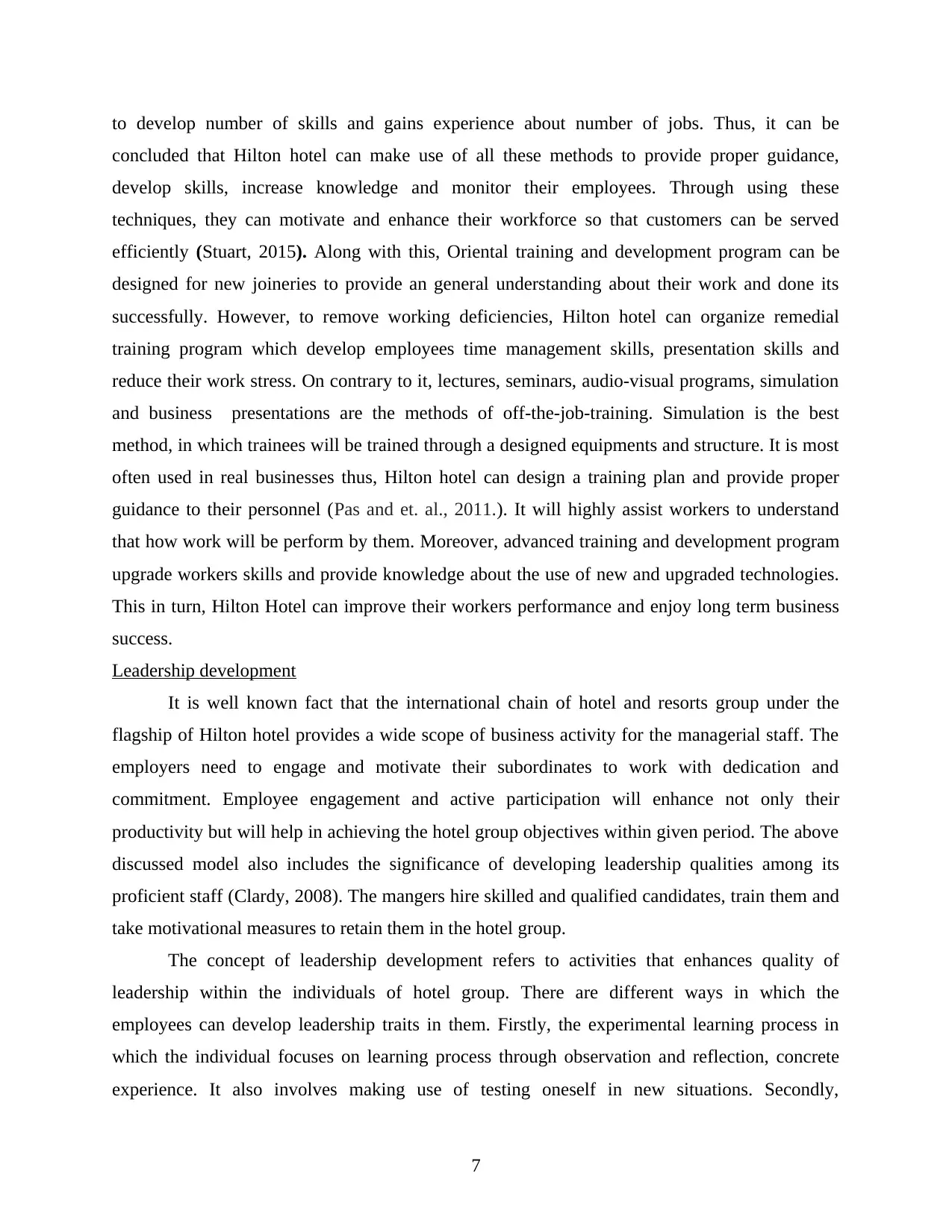
to develop number of skills and gains experience about number of jobs. Thus, it can be
concluded that Hilton hotel can make use of all these methods to provide proper guidance,
develop skills, increase knowledge and monitor their employees. Through using these
techniques, they can motivate and enhance their workforce so that customers can be served
efficiently (Stuart, 2015). Along with this, Oriental training and development program can be
designed for new joineries to provide an general understanding about their work and done its
successfully. However, to remove working deficiencies, Hilton hotel can organize remedial
training program which develop employees time management skills, presentation skills and
reduce their work stress. On contrary to it, lectures, seminars, audio-visual programs, simulation
and business presentations are the methods of off-the-job-training. Simulation is the best
method, in which trainees will be trained through a designed equipments and structure. It is most
often used in real businesses thus, Hilton hotel can design a training plan and provide proper
guidance to their personnel (Pas and et. al., 2011.). It will highly assist workers to understand
that how work will be perform by them. Moreover, advanced training and development program
upgrade workers skills and provide knowledge about the use of new and upgraded technologies.
This in turn, Hilton Hotel can improve their workers performance and enjoy long term business
success.
Leadership development
It is well known fact that the international chain of hotel and resorts group under the
flagship of Hilton hotel provides a wide scope of business activity for the managerial staff. The
employers need to engage and motivate their subordinates to work with dedication and
commitment. Employee engagement and active participation will enhance not only their
productivity but will help in achieving the hotel group objectives within given period. The above
discussed model also includes the significance of developing leadership qualities among its
proficient staff (Clardy, 2008). The mangers hire skilled and qualified candidates, train them and
take motivational measures to retain them in the hotel group.
The concept of leadership development refers to activities that enhances quality of
leadership within the individuals of hotel group. There are different ways in which the
employees can develop leadership traits in them. Firstly, the experimental learning process in
which the individual focuses on learning process through observation and reflection, concrete
experience. It also involves making use of testing oneself in new situations. Secondly,
7
concluded that Hilton hotel can make use of all these methods to provide proper guidance,
develop skills, increase knowledge and monitor their employees. Through using these
techniques, they can motivate and enhance their workforce so that customers can be served
efficiently (Stuart, 2015). Along with this, Oriental training and development program can be
designed for new joineries to provide an general understanding about their work and done its
successfully. However, to remove working deficiencies, Hilton hotel can organize remedial
training program which develop employees time management skills, presentation skills and
reduce their work stress. On contrary to it, lectures, seminars, audio-visual programs, simulation
and business presentations are the methods of off-the-job-training. Simulation is the best
method, in which trainees will be trained through a designed equipments and structure. It is most
often used in real businesses thus, Hilton hotel can design a training plan and provide proper
guidance to their personnel (Pas and et. al., 2011.). It will highly assist workers to understand
that how work will be perform by them. Moreover, advanced training and development program
upgrade workers skills and provide knowledge about the use of new and upgraded technologies.
This in turn, Hilton Hotel can improve their workers performance and enjoy long term business
success.
Leadership development
It is well known fact that the international chain of hotel and resorts group under the
flagship of Hilton hotel provides a wide scope of business activity for the managerial staff. The
employers need to engage and motivate their subordinates to work with dedication and
commitment. Employee engagement and active participation will enhance not only their
productivity but will help in achieving the hotel group objectives within given period. The above
discussed model also includes the significance of developing leadership qualities among its
proficient staff (Clardy, 2008). The mangers hire skilled and qualified candidates, train them and
take motivational measures to retain them in the hotel group.
The concept of leadership development refers to activities that enhances quality of
leadership within the individuals of hotel group. There are different ways in which the
employees can develop leadership traits in them. Firstly, the experimental learning process in
which the individual focuses on learning process through observation and reflection, concrete
experience. It also involves making use of testing oneself in new situations. Secondly,
7
⊘ This is a preview!⊘
Do you want full access?
Subscribe today to unlock all pages.

Trusted by 1+ million students worldwide
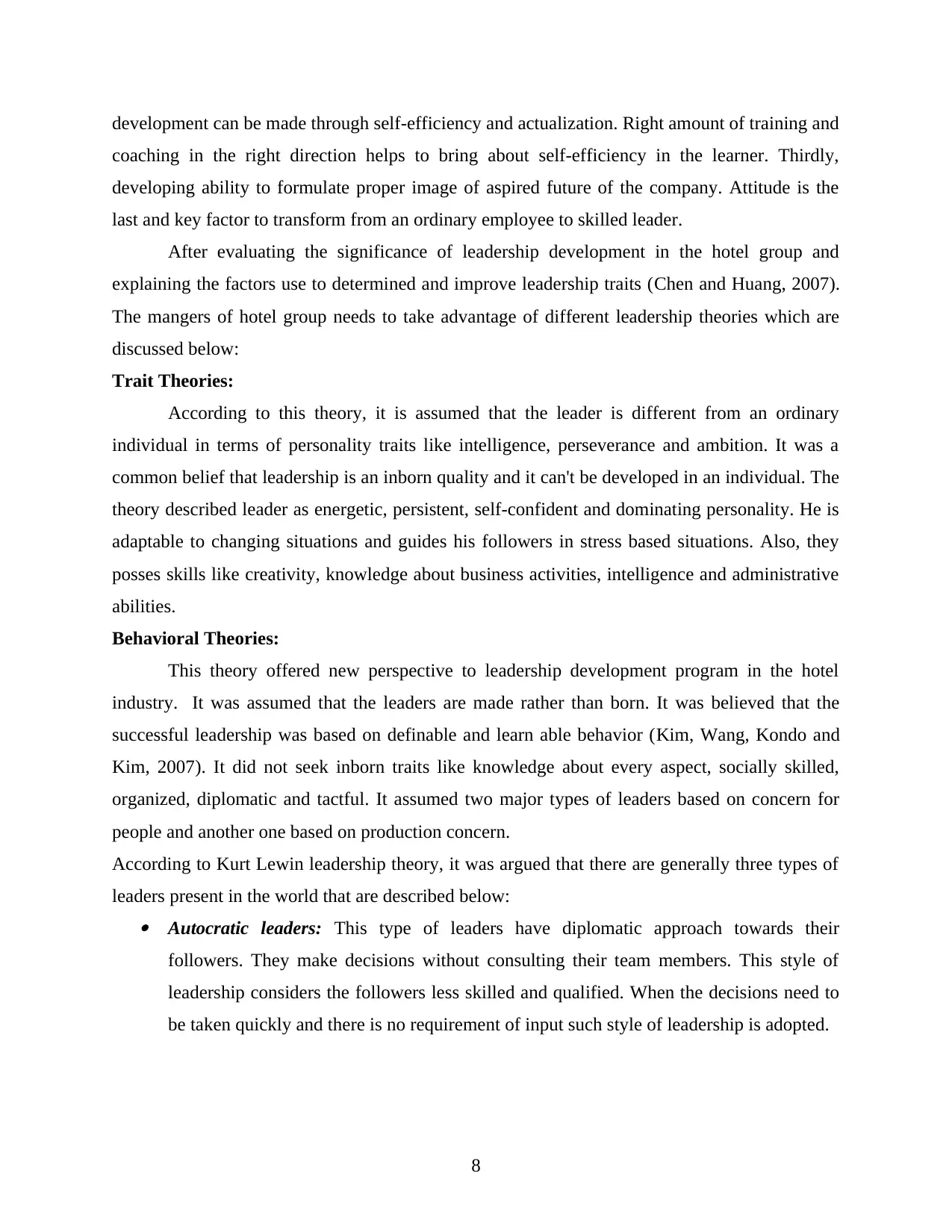
development can be made through self-efficiency and actualization. Right amount of training and
coaching in the right direction helps to bring about self-efficiency in the learner. Thirdly,
developing ability to formulate proper image of aspired future of the company. Attitude is the
last and key factor to transform from an ordinary employee to skilled leader.
After evaluating the significance of leadership development in the hotel group and
explaining the factors use to determined and improve leadership traits (Chen and Huang, 2007).
The mangers of hotel group needs to take advantage of different leadership theories which are
discussed below:
Trait Theories:
According to this theory, it is assumed that the leader is different from an ordinary
individual in terms of personality traits like intelligence, perseverance and ambition. It was a
common belief that leadership is an inborn quality and it can't be developed in an individual. The
theory described leader as energetic, persistent, self-confident and dominating personality. He is
adaptable to changing situations and guides his followers in stress based situations. Also, they
posses skills like creativity, knowledge about business activities, intelligence and administrative
abilities.
Behavioral Theories:
This theory offered new perspective to leadership development program in the hotel
industry. It was assumed that the leaders are made rather than born. It was believed that the
successful leadership was based on definable and learn able behavior (Kim, Wang, Kondo and
Kim, 2007). It did not seek inborn traits like knowledge about every aspect, socially skilled,
organized, diplomatic and tactful. It assumed two major types of leaders based on concern for
people and another one based on production concern.
According to Kurt Lewin leadership theory, it was argued that there are generally three types of
leaders present in the world that are described below: Autocratic leaders: This type of leaders have diplomatic approach towards their
followers. They make decisions without consulting their team members. This style of
leadership considers the followers less skilled and qualified. When the decisions need to
be taken quickly and there is no requirement of input such style of leadership is adopted.
8
coaching in the right direction helps to bring about self-efficiency in the learner. Thirdly,
developing ability to formulate proper image of aspired future of the company. Attitude is the
last and key factor to transform from an ordinary employee to skilled leader.
After evaluating the significance of leadership development in the hotel group and
explaining the factors use to determined and improve leadership traits (Chen and Huang, 2007).
The mangers of hotel group needs to take advantage of different leadership theories which are
discussed below:
Trait Theories:
According to this theory, it is assumed that the leader is different from an ordinary
individual in terms of personality traits like intelligence, perseverance and ambition. It was a
common belief that leadership is an inborn quality and it can't be developed in an individual. The
theory described leader as energetic, persistent, self-confident and dominating personality. He is
adaptable to changing situations and guides his followers in stress based situations. Also, they
posses skills like creativity, knowledge about business activities, intelligence and administrative
abilities.
Behavioral Theories:
This theory offered new perspective to leadership development program in the hotel
industry. It was assumed that the leaders are made rather than born. It was believed that the
successful leadership was based on definable and learn able behavior (Kim, Wang, Kondo and
Kim, 2007). It did not seek inborn traits like knowledge about every aspect, socially skilled,
organized, diplomatic and tactful. It assumed two major types of leaders based on concern for
people and another one based on production concern.
According to Kurt Lewin leadership theory, it was argued that there are generally three types of
leaders present in the world that are described below: Autocratic leaders: This type of leaders have diplomatic approach towards their
followers. They make decisions without consulting their team members. This style of
leadership considers the followers less skilled and qualified. When the decisions need to
be taken quickly and there is no requirement of input such style of leadership is adopted.
8
Paraphrase This Document
Need a fresh take? Get an instant paraphrase of this document with our AI Paraphraser

Democratic leaders: Under this style of leadership the team members are independent to
perform the tasks though they have some responsibility towards their mangers or leaders.
It is important when the team members are difficult to manage a situation in critical time.
Laissez-faire leaders: In this type of leadership style, there is no interference occurred
from the leaders of the company. The employees work efficiently and in skilled manner
as they are skilled and masters in their respective fields. Leaders focus on providing
complete flexibility to these employees for the business.
CONCLUSION
The above report provides an extensive information about various factors involved in HR
issues and management. It helps the companies in analyzing the factors responsible for growth
and development of the employees. Need of strategic HRM has helped business units in
changing perspectives of management for employees and their significance within the business.
It also contributes effectively in determining the issues that are crucial for enhancing employee
development within the business.
9
perform the tasks though they have some responsibility towards their mangers or leaders.
It is important when the team members are difficult to manage a situation in critical time.
Laissez-faire leaders: In this type of leadership style, there is no interference occurred
from the leaders of the company. The employees work efficiently and in skilled manner
as they are skilled and masters in their respective fields. Leaders focus on providing
complete flexibility to these employees for the business.
CONCLUSION
The above report provides an extensive information about various factors involved in HR
issues and management. It helps the companies in analyzing the factors responsible for growth
and development of the employees. Need of strategic HRM has helped business units in
changing perspectives of management for employees and their significance within the business.
It also contributes effectively in determining the issues that are crucial for enhancing employee
development within the business.
9

REFERENCES
Books and Journals
Bilton, C., 2007. Management and creativity: From creative industries to creative management.
Blackwell Publishing.
Chen, C. J. and Huang, J. W., 2007. How organizational climate and structure affect knowledge
management—The social interaction perspective.International Journal of Information
Management. 27(2). Pp. 104-118.
Chen, C. J. and Huang, J. W., 2009. Strategic human resource practices and innovation
performance—The mediating role of knowledge management capacity. Journal of Business
Research. 62(1). pp.104-114.
Clardy, A., 2008. Policies for managing the training and development function: lessons from the
federal government. Public Personnel Management. 37(1). pp.27-54.
Cummings, T. and Worley, C., 2014. Organization development and change. Cengage Learning.
Dezdar, S. and Sulaiman, A., 2009. Successful enterprise resource planning implementation:
taxonomy of critical factors. Industrial Management & Data Systems. 109(8). pp. 1037-
1052.
Eagly, A. H., Johannesen-Schmidt, M. C. and Van Engen, M. L., 2003. Transformational,
transactional, and laissez-faire leadership styles: a meta-analysis comparing women and
men. Psychological bulletin, 129(4), 569.
Gallicano, T. D., 2009. Personal relationship strategies and outcomes in a membership
organization. Journal of Communication Management. 13(4). pp.310-328.
Kim, T. Y., Wang, C., Kondo, M. and Kim, T. H., 2007. Conflict management styles: the
differences among the Chinese, Japanese, and Koreans.International Journal of Conflict
Management. 18(1). Pp. 23-41.
Meredith Belbin, R. 2011. Management teams: Why they succeed or fail. Human Resource
Management International Digest. 19(3).
Nikandrou, I., and Papalexandris, N., 2007. The impact of M&A experience on strategic HRM
practices and organisational effectiveness: Evidence from Greek firms. Human Resource
Management Journal. 17(2). Pp.155-177.
Pas, B., and et. al., 2011. Feminisation of the medical profession: a strategic HRM dilemma? The
effects of family‐friendly HR practices on female doctors' contracted working hours.Human
Resource Management Journal. 21(3). Pp. 285-302.
Storey, J., 2007. Human resource management: A critical text. Cengage Learning EMEA.
Ulrich, D., 2013. Human resource champions: The next agenda for adding value and delivering
results. Harvard Business Press.
Online
10
Books and Journals
Bilton, C., 2007. Management and creativity: From creative industries to creative management.
Blackwell Publishing.
Chen, C. J. and Huang, J. W., 2007. How organizational climate and structure affect knowledge
management—The social interaction perspective.International Journal of Information
Management. 27(2). Pp. 104-118.
Chen, C. J. and Huang, J. W., 2009. Strategic human resource practices and innovation
performance—The mediating role of knowledge management capacity. Journal of Business
Research. 62(1). pp.104-114.
Clardy, A., 2008. Policies for managing the training and development function: lessons from the
federal government. Public Personnel Management. 37(1). pp.27-54.
Cummings, T. and Worley, C., 2014. Organization development and change. Cengage Learning.
Dezdar, S. and Sulaiman, A., 2009. Successful enterprise resource planning implementation:
taxonomy of critical factors. Industrial Management & Data Systems. 109(8). pp. 1037-
1052.
Eagly, A. H., Johannesen-Schmidt, M. C. and Van Engen, M. L., 2003. Transformational,
transactional, and laissez-faire leadership styles: a meta-analysis comparing women and
men. Psychological bulletin, 129(4), 569.
Gallicano, T. D., 2009. Personal relationship strategies and outcomes in a membership
organization. Journal of Communication Management. 13(4). pp.310-328.
Kim, T. Y., Wang, C., Kondo, M. and Kim, T. H., 2007. Conflict management styles: the
differences among the Chinese, Japanese, and Koreans.International Journal of Conflict
Management. 18(1). Pp. 23-41.
Meredith Belbin, R. 2011. Management teams: Why they succeed or fail. Human Resource
Management International Digest. 19(3).
Nikandrou, I., and Papalexandris, N., 2007. The impact of M&A experience on strategic HRM
practices and organisational effectiveness: Evidence from Greek firms. Human Resource
Management Journal. 17(2). Pp.155-177.
Pas, B., and et. al., 2011. Feminisation of the medical profession: a strategic HRM dilemma? The
effects of family‐friendly HR practices on female doctors' contracted working hours.Human
Resource Management Journal. 21(3). Pp. 285-302.
Storey, J., 2007. Human resource management: A critical text. Cengage Learning EMEA.
Ulrich, D., 2013. Human resource champions: The next agenda for adding value and delivering
results. Harvard Business Press.
Online
10
⊘ This is a preview!⊘
Do you want full access?
Subscribe today to unlock all pages.

Trusted by 1+ million students worldwide
1 out of 13
Related Documents
Your All-in-One AI-Powered Toolkit for Academic Success.
+13062052269
info@desklib.com
Available 24*7 on WhatsApp / Email
![[object Object]](/_next/static/media/star-bottom.7253800d.svg)
Unlock your academic potential
Copyright © 2020–2025 A2Z Services. All Rights Reserved. Developed and managed by ZUCOL.





